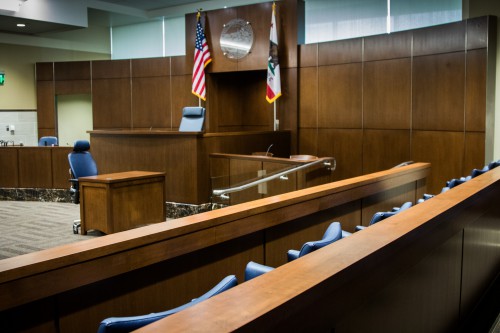 By Mariel Barbadillo and Sophie Marconi
By Mariel Barbadillo and Sophie Marconi
On September 20, 2016, Judge Paul Richardson presided over the second day of witness testimonies in the trial of Darnell Dorsey. Mr. Dorsey is charged with assaulting and inflicting deadly injury upon his girlfriend’s 20-month-old child, Cameron Morrison.
The prosecution called on Dr. Paul Lee to complete his testimony from the day before. Deputy District Attorney Michelle Serafin questioned Dr. Lee about hypoxia, or lack of oxygen to tissues, in this case, the brain. Dr. Lee confirmed that hypoxia can cause swelling of the brain, such as the swelling he observed in Cameron’s brain.
Dr. Lee stated that cardiac arrest could cause hypoxia and brain swelling. It occurs in adults and children, but it typically only occurs in children with heart problems. When asked if Cameron had issues with his heart, Dr. Lee stated the child’s heart appeared normal.
The prosecution then presented a computerized tomography (CT) scan image of a brain. Dr. Lee described the brain in the image as “normal.” He went on to discuss the differentiation between gray matter and white matter, indicating what a brain typically looks like.
Next, the prosecution showed CT scan images of Cameron’s head taken at the UC Davis Medical Center. There appeared to be a lack of differentiation between the gray matter and white matter. Dr. Lee said the initial CT scan of Cameron’s brain from Sutter Davis Hospital looked “normal,” but the loss of gray and white matter differentiation was much more significant by the time Cameron was brought to UC Davis.
Dr. Lee stated Cameron had a normal cervical spine, and he did not exhibit visible injuries to his bones or soft tissue. Still, Dr. Lee does not exclude the possibility of trauma, because trauma injuries are not limited to the cervical spine.
During cross-examination, Deputy Public Defender Joseph Gocke clarified that a Diffuse Axonal Injury (DAI) consists of lesions widespread in the white matter of the brain, which Dr. Lee confirmed is correct.
Mr. Gocke went on to question Dr. Lee about one of his colleagues who found no focal mass lesion in Cameron’s brain. Mr. Gocke asked if that finding is inconsistent with DAI, but Dr. Lee said that finding does not exclude the possibility of a DAI.
The defense then asked Dr. Lee about Global Cerebral Ischemia, referring to a drastic lack of blood flow to the brain, which can result in brain swelling and death. Respiratory arrest can cause both brain swelling and death, while pneumonia can cause respiratory arrest.
In redirect examination, Ms. Serafin asked how pneumonia causes respiratory arrest. Dr. Lee stated that pus in the air space impedes the exchange of carbon dioxide and oxygen, causing difficulty breathing and potentially respiratory arrest. However, both lungs would need to be infected for respiratory arrest to occur.
Dr. Lee said that, on CT scans and MRIs, medical practitioners are able to see lesions on a person’s brain. The prosecution asked Dr. Lee if he saw lesions on Cameron’s brain. Dr. Lee answered that he did not, but he did not exclude Diffuse Axonal Injury because imaging technologies have limitations.
When asked if other events can cause injuries similar to those Cameron sustained, Dr. Lee said a car accident could cause such injuries, especially if the person is not wearing a seat belt.
The prosecution’s next witness was Dr. Kee Kim, a neurosurgeon at the UC Davis Medical Center, who was consulted concerning Cameron’s condition.
Dr. Kim observed an anoxic brain injury (an injury to the brain due to lack of oxygen), but “more compelling” was the apparent lack of circulation to the brain. When asked why it was “more compelling,” Dr. Kim stated that nothing at that point could be done to make a difference in Cameron’s condition.
The witness said this type of brain injury is most common in children, referring to it as “shaken baby syndrome.”
During cross-examination, Deputy Public Defender Martha Sequeira asked Dr. Kim whether or not he knew that the American Pediatric Association stopped using the term (shaken baby syndrome) because it has found that the human force of shaking a baby cannot alone cause the injuries associated with non-accidental trauma. He answered that he did not know that.
In redirect examination, Dr. Kim clarified that his use of the term, shaken baby syndrome, referred to general non-accidental trauma injuries to children of Cameron’s age group.
The next witness was Dr. Matt Wayment, a pediatric critical care specialist who worked at the UC Davis Medical Center in January 2014 and tended to Cameron during his last day.
When Dr. Wayment examined Cameron, he found the child had no reflexes and exhibited retinal hemorrhages in both eyes. He also noticed external signs of trauma, specifically dark patches on Cameron’s back and bruising behind his left ear, which Dr. Wayment found concerning and unusual.
Dr. Wayment diagnosed Cameron with non-accidental trauma. He came to this conclusion due to the rib fracture, healing rib fractures, blood in the child’s eyes, and blood in his brain. The doctor found these injuries consistent with shaken baby syndrome.
The prosecution asked if pneumonia could cause cardiac arrest. The witness confirmed that it is possible. The prosecution asked if a patient can develop pneumonia in the hospital, and the witness confirmed that it is also possible. However, Dr. Wayment did not hear or see signs of pneumonia. Also, Cameron’s white blood cell counts were not elevated, as they would be if he had an infection.
Dr. Wayment stated that the broken blood vessels in the back of Cameron’s eyes were consistent with head trauma, while the liver laceration was indicative of inflicted trauma. The child falling cannot cause such a laceration; a penetrating or direct blow likely caused the tearing.
He went on to say that it is not typical for children less than two years of age to have broken ribs. It is typically caused by trauma. When asked if ribs can be broken due to CPR, Dr. Wayment said that, in his experience, CPR cannot cause broken ribs. He postulated that blunt force trauma or squeezing caused the injury.
Dr. Wayment stated he has had 25 or so patients with similar injuries, all of which were caused by non-accidental trauma.
Mr. Gocke cross-examined the witness by asking if grabbing a child could cause injury to posterior ribs. Dr. Wayment said it is possible, but the person would have to be grabbing the child very tightly.
Judge Richardson dismissed the jury for their lunch break a few minutes early to give defense counsel the opportunity to address their concerns. The defense questioned the subject matter of the prosecution’s discussion with Dr. Wayment prior to his testimony. Mr. Gocke argued that Dr. Wayment’s testimony was more polished than that of the other witnesses, and he disclosed information that was not provided to the defense. Mr. Gocke asked for time to receive and review the new discovery before proceeding with cross-examination.
The prosecution claimed they only spoke to the witness to clarify certain statements and terminology. Both prosecuting attorneys took notes during their discussion with Dr. Wayment, as did the investigator who was present at the meeting.
The court ordered that the three sets of notes be turned over to the defense. Judge Richardson denied the defense’s request for a continuance to review new discovery.
Afternoon Session
Department 13 got a late start in the afternoon, and Dr. Wayment continued his testimony regarding Cameron’s death and the physiological events that led up to it.
Dr. Wayment testified that he heard no abnormal sounds coming from Cameron’s lungs during Cameron’s hospitalization, though other members of the faculty have stated that they noticed diminished breathing.
Wayment later explained the definition of hypoxia, which is when a region of the body is deprived of oxygen. He also told the court that Cameron had a noticeable bruise on his head a week prior to hospitalization, which he learned from the child’s mother.
Dr. Wayment also stated that he directly reviewed the CT and MRI scans of Cameron’s brain.
The defense asked Dr. Wayment if he knew the other doctors he was working with, as he was the attending physician and this is part of his duty. The doctor admitted that he did not know the other doctors.
Wayment told the court that, while Cameron had low calcium levels and low magnesium levels, the calcium that was circulating in his blood was at a normal level.
The doctor also stated that it is possible for ribs to break during violent coughing and vomiting fits, which is relevant because Cameron was ill during the days leading up to his death.
Dr. Wayment also explained that medical professionals receive specialized training regarding CPR performance on a child, because of the heightened risk associated with children.
The defense asked the doctor if someone who is not experienced in CPR, such as Darnell Dorsey, could accidentally break a rib because of this lack of training. Dr. Wayment stated that this was possible.
The case will resume tomorrow, September 21, at 8:30 am.




